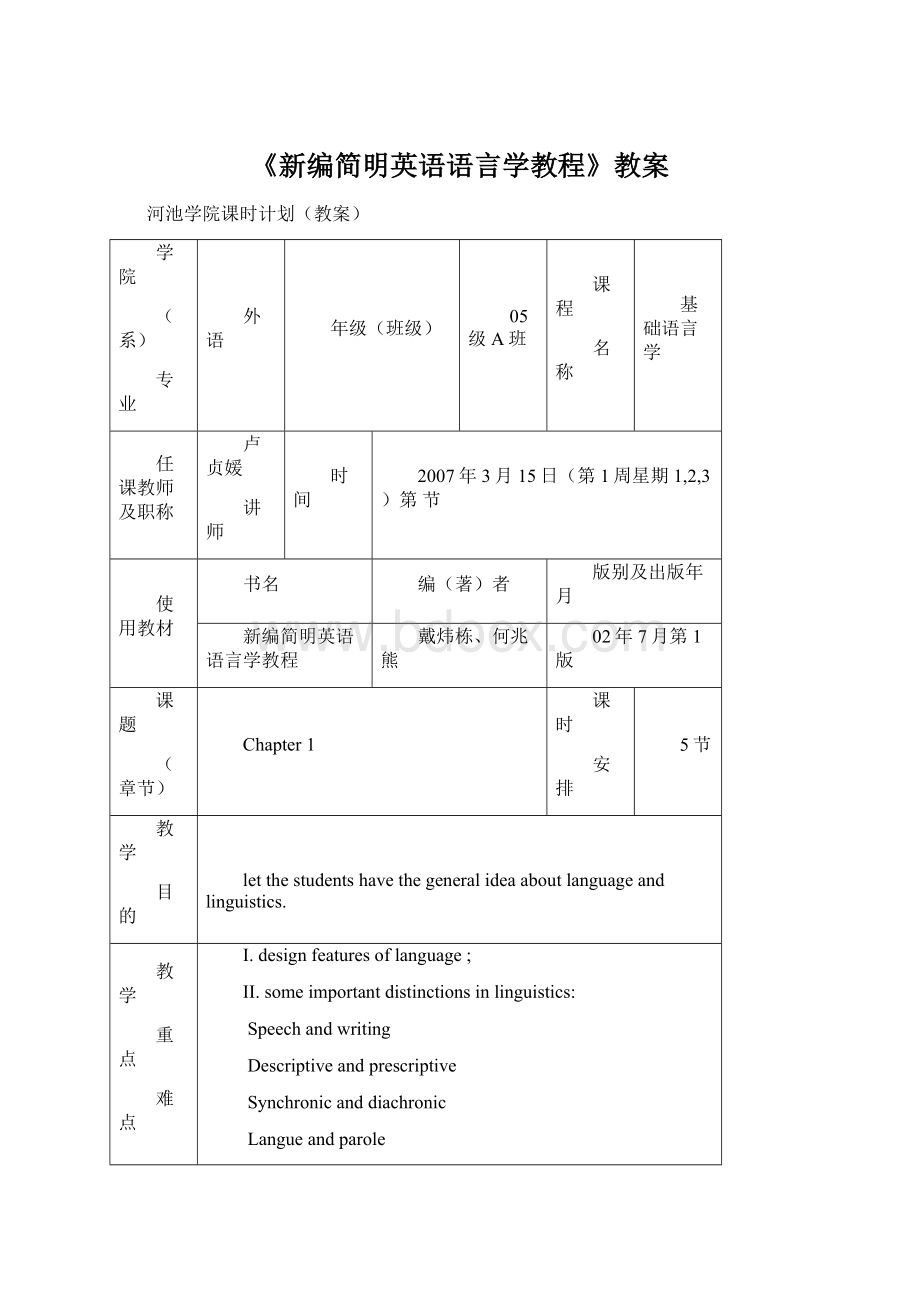《新编简明英语语言学教程》教案.docx
《《新编简明英语语言学教程》教案.docx》由会员分享,可在线阅读,更多相关《《新编简明英语语言学教程》教案.docx(53页珍藏版)》请在冰豆网上搜索。

《新编简明英语语言学教程》教案
河池学院课时计划(教案)
学院
(系)
专业
外语
年级(班级)
05级A班
课程
名称
基础语言学
任课教师及职称
卢贞媛
讲师
时间
2007年3月15日(第1周星期1,2,3)第节
使用教材
书名
编(著)者
版别及出版年月
新编简明英语语言学教程
戴炜栋、何兆熊
02年7月第1版
课题
(章节)
Chapter1
课时
安排
5节
教学
目的
letthestudentshavethegeneralideaaboutlanguageandlinguistics.
教学
重点
难点
I.designfeaturesoflanguage;
II.someimportantdistinctionsinlinguistics:
Speechandwriting
Descriptiveandprescriptive
Synchronicanddiachronic
Langueandparole
Competenceandperformance
Traditionalgrammarandmodernlinguistics
教学
方法
CommunicativeMethods
教学
内容
及过
程
作业
或思
考题
Homework:
exercises3.5.6.
教学后记
Chapter1Introduction
Date:
March12,2007
Teachingaims:
letthestudentshavethegeneralideaaboutlanguageandlinguistics.
Teachingdifficulties:
designfeaturesoflanguage;someimportantdistinctionsinlinguistics
Teachingprocedures
1.Whatislinguistics?
1.1Definition
Linguisticsisascientificstudyoflanguage.Itisamajorbranchofsocialscience.
Linguisticsstudiesnotjustonelanguageofanysociety,butthelanguageofallhumansociety,languageingeneral.
Ascientificstudyisonewhichisbasedonthesystematicinvestigationofdata,conductedwithreferencetosomegeneraltheoryoflanguagestructure.
observation------generalization-----hypothesis------testedbyfurtherobservation------theory
1.2Mainbranches(scope)oflinguistics
Generallinguistics—thestudyoflanguageasawhole.
1)mainbranches
phonetics语音学–thestudyofsoundsusedinlinguisticcommunication
phonology音系学(音位学)--thestudyofhowsoundsareputtogetherandusedtoconveymeaningincommunication.
morphology词法学—thestudyofthewayinwhichthesesymbolsarearrangedandcombinedtoformwords
syntax句法学–thestudyoftheruleswhichgovernthecombinationofwordstoformgrammaticallypermissiblesentencesinlanguages.
semantics语义学—thestudyofmeaning.
pragmatics语用学—thestudyofmeaninginthecontextoflanguageuse
2)interdisciplinary(跨学科的)branchesoflinguisticstudy
sociolinguistics–thestudyofallsocialaspectsoflanguageanditsrelationwithsociety.E.g.languageusedandsocialbackground(thedifferencebetweentheeducatedanduneducatedpeople);languageusedandcertainoccasion(formalandinformalsettings);languagechangeandsocialchange(newwords)
psycholinguistics–itaimstoanswersuchquestionsashowthehumanmindworkswhenweuselanguage,howweasinfantsacquireourmothertongue,howweememorize,andhowweprocesstheinformationwereceiveinthecourseofcommunication.
Appliedlinguistics–findingsinlinguisticstudiescanoftenbeappliedtothesolutionofsuchpracticalproblemsastherecoveryofspeechability.Thestudyofsuchapplicationsisgenerallyknownasappliedlinguistics.Inanarrowsenseitreferstotheapplicationoflinguistictheoriesandprinciplestolanguageteaching,especiallytheteachingofforeignandsecondlanguages.
1.3Importantdistinctionsinlinguistics
a.Descriptivevs.prescriptive“描写式”和“规定式”
Theyrepresenttwodifferenttypesoflinguisticstudy.
Ifalinguisticstudyaimstodescribeandanalyzethelanguagepeopleactuallyuse,itissaidtobedescriptive;ifthelinguisticstudyaimstolaydownrulesfor“correctandstandard”behaviorinusinglanguage,i.e.totellpeoplewhattheyshouldsayandwhattheyshouldnotsay,itissaidtobeprescriptive.
Grammar–prescriptiveModernlinguistics–descriptive
b.Synchronicvs.diachronic“共时”和“历时”
Thedescriptionofalanguageatsomepointoftimeinhistoryisasynchronicstudy;thedescriptionoflanguageasitchangesthroughtimeisadiachronicstudy.Adiachronicstudyisahistoricalstudy;itstudiesthehistoricaldevelopmentoflanguageoveraperiodoftime.
Synchronic(modernlinguistics)
diachronic(historicalstudy)
c.speechandwriting
firstlearnedandtaught
d.langue&parole“语言”和“言语”
ThedistinctionwasmadebytheSwisslinguistSaussureintheearly20thcentury.
Languereferstotheabstractlinguisticsystemsharedbyallmembersofaspeechcommunity.(conventionsandrules–abstract–notspokenbyanyone–stable)
parolereferstotherealizationoflanguageinactualuse.(realizationsoflanguage–concrete—anaturallyoccurringevent–changeable)
langue:
1)theabstractsystem
2)itissocial,asetofconventions
3)relativelystableandsystematic
parole:
1)theactualizationoflanguage
2)itispersonal,itistheconcreteuseofconventions
3)itismorevariableandmayalter
Whatlinguistsshoulddoistoabstractlanguefromparole,i.e.todiscovertheregularitiesgoverningtheactualuseoflanguageandmakethemthesubjectsofstudyoflinguistics.
e.Competenceandperformance语言能力和语言运用
ThedistinctionisdiscussedbytheAmericanlinguistN.Chomskyinthelate1950’s.
Competence----theidealuser’sknowledgeoftherulesofhislanguage.
Performance----theactualrealizationofthisknowledgeinlinguisticcommunication.
f.Traditionalgrammarandmodernlinguistics
ModernlinguisticsstartedwiththepublicationofF.deSaussure’sbook“CourseinGeneralLinguistics”intheearly20thcentury.SoSaussureisoftendescribedas“fatherofmodernlinguistics”.
Thegeneralapproachtraditionallyformedtothestudyoflanguagebeforethatisroughlyreferredtoas“traditionalgrammar.”Theydifferinseveralbasicways:
Firstly,linguisticsisdescriptivewhiletraditionalgrammarisprescriptive.Alinguistisinterestedinwhatissaid,notinwhathethinksoughttobesaid.Hedescribeslanguageinallitsaspects,butdoesnotprescriberulesof“correctness”.
Secondly,modernlinguisticsregardsthespokenlanguageasprimary,notthewritten.Traditionalgrammarians,ontheotherhand,tendtoemphasize,maybeover-emphasize,theimportanceofthewrittenword,partlybecauseofitspermanence.
Then,modernlinguisticsdiffersfromtraditionalgrammaralsointhatitdoesnotforcelanguagesintoaLatin-basedframework.Tomodernlinguists,itisunthinkabletojudgeonelanguagebystandardsofanother.Theyaretryingtosetupauniversalframework,butthatwouldbebasedonthefeaturessharedbymostofthelanguagesusedbymankind.
2.Language
2.1Whystudylanguage?
Atoolforcommunication
Anintegralpartofourlifeandhumanity
Ifwearenotfullyawareofthenatureandmechanismofourlanguage,wewillbeignorantofwhatconstitutesouressentialhumanity.
2.2Whatislanguage?
2.2.1differentsensesoflanguage
whatapersonsays(concreteactofspeech)
aperson’sconsistentwayofspeakingorwriting
aparticularlevelofspeakingorwritinge.g.colloquiallanguage
anabstractsystem
2.2.2definitions
Languageisasystemofarbitraryvocalsymbolsusedforhumancommunication.
Whatiscommunication?
Aprocessinwhichinformationistransmittedfromasource(senderorspeaker)toagoal(receiverorlistener).
Asystem----elementsinitarearrangedaccordingtocertainrules.Theycannotbearrangedatwill.
e.g.Hethetablecleaned.(×)bkli(×)
Arbitrary----thereisnointrinsic(logic)connectionbetweenalinguisticformanditsmeaning.
Symbols----wordsarejustthesymbolsassociatedwithobjects,actions,andideasbyconvention.
Vocal--------theprimarymediumforalllanguagesissound,nomatterhowwelldevelopedtheirwritingsystemsare.
Writingsystemscameintobeingmuchlaterthanthespokenforms.
Peoplewithlittleornoliteracycanalsobecompetentlanguageusers.
Human----languageishuman-specific.
Humanbeingshavedifferentkindsofbrainsandvocalcapacity.
“LanguageAcquisitionDevice”(LAD)
1.3Designfeaturesoflanguage语言的结构特征
Designfeaturesreferstothedefiningpropertiesofhumanlanguagethatdistinguishitfromanyanimalsystemofcommunication.
a.arbitrariness----theformoflinguisticsignsbearnonaturalrelationshiptotheirmeaning.Thelinkbetweenthemisamatterofconvention.
E.g.“house”uchi(Japanese)
Mansion(French)
房子(Chinese)
“dog”gou(Chinese)
chien(French)
conventionality----Itmeansthatinanylanguagetherearecertainsequencesofsoundsthathaveaconventionallyacceptedmeaning.Thosewordsarecustomarilyusedbyallspeakerswiththesameintendedmeaningandunderstoodbyalllistenersinthesameway.
Therearetwodifferentschoolsofbeliefconcerningarbitrariness.Mostpeople,especiallystructurallinguistsbelievethatlanguageisarbitrarybynature.Otherpeople,however,holdthatlanguageisiconic(图标的),thatis,thereisadirectrelationorcorrespondencebetweensoundandmeaning,suchasonomatopoeia.(cuckoo;crash)
Forthemajorityofanimalsignals,theredoesappeartobeaclearconnectionbetweentheconveyedmessageandthesignalusedtoconveyit,Andforthem,thesetsofsignalsusedincommunicationisfinite.
b.Productivity/Creativity----languageisresourceful.Itmakespossibletheconstructionandinterpretationofnewsignalsbyitsusers.(novelutterancesarecontinuallybeingcreated.)
non-humansignals,ontheotherhand,appearstohavelittleflexibility.
e.g.anexperimentofbeecommunication:
Theworkerbee,normallyabletocommunicatethelocationofanectarsource,willfailtodosoifthelocationisreally‘new’.Inoneexperiment,ahiveofbeeswasplacedatthefootofaradiotowerandafoodsourceatthetop.Tenbeesweretakentothetop,shownthefoodsource,andsentofftotelltherestofthehiveabouttheirfind.Themessagewasconveyedviaabeedanceandthewholegangbuzzedofftogetthefreefood.Theyflowaroundinalldirections,butcouldn’tlocatethefood.Theproblemmaybethatbeecommunicationregardinglocation